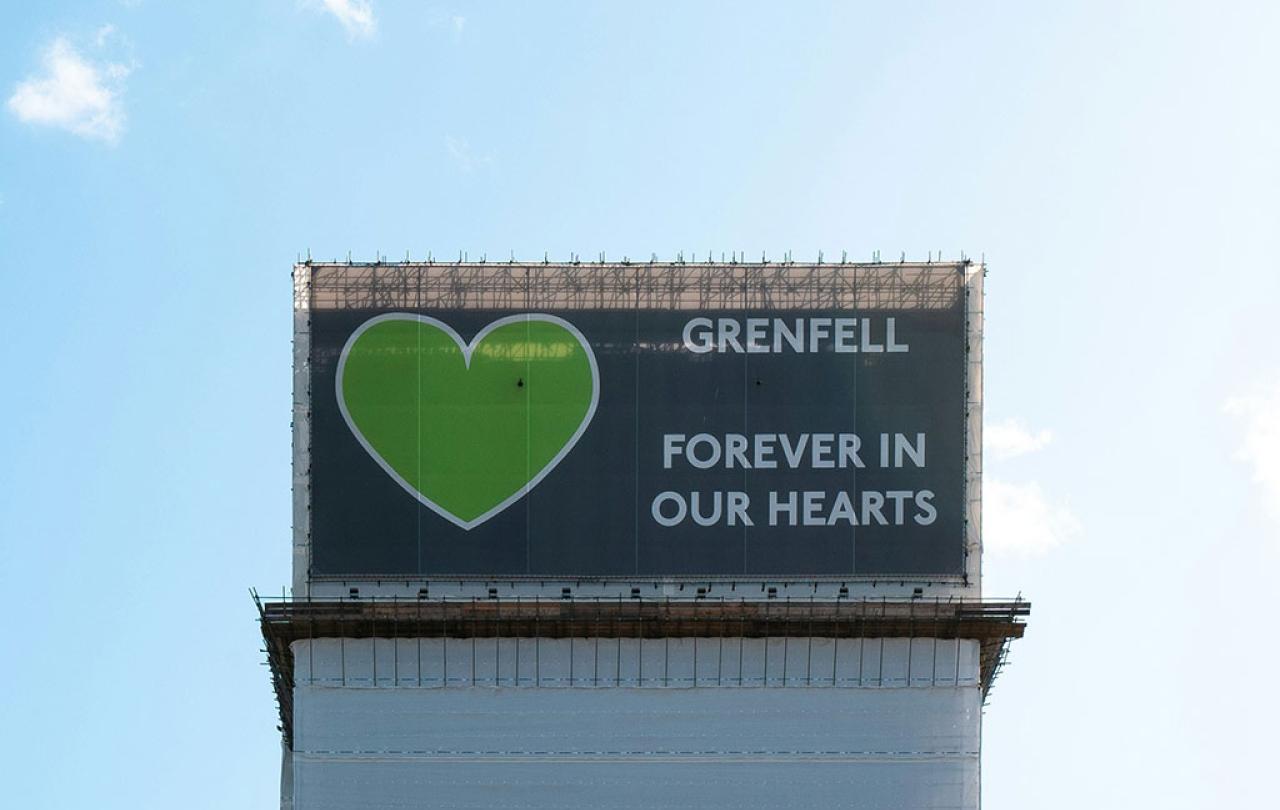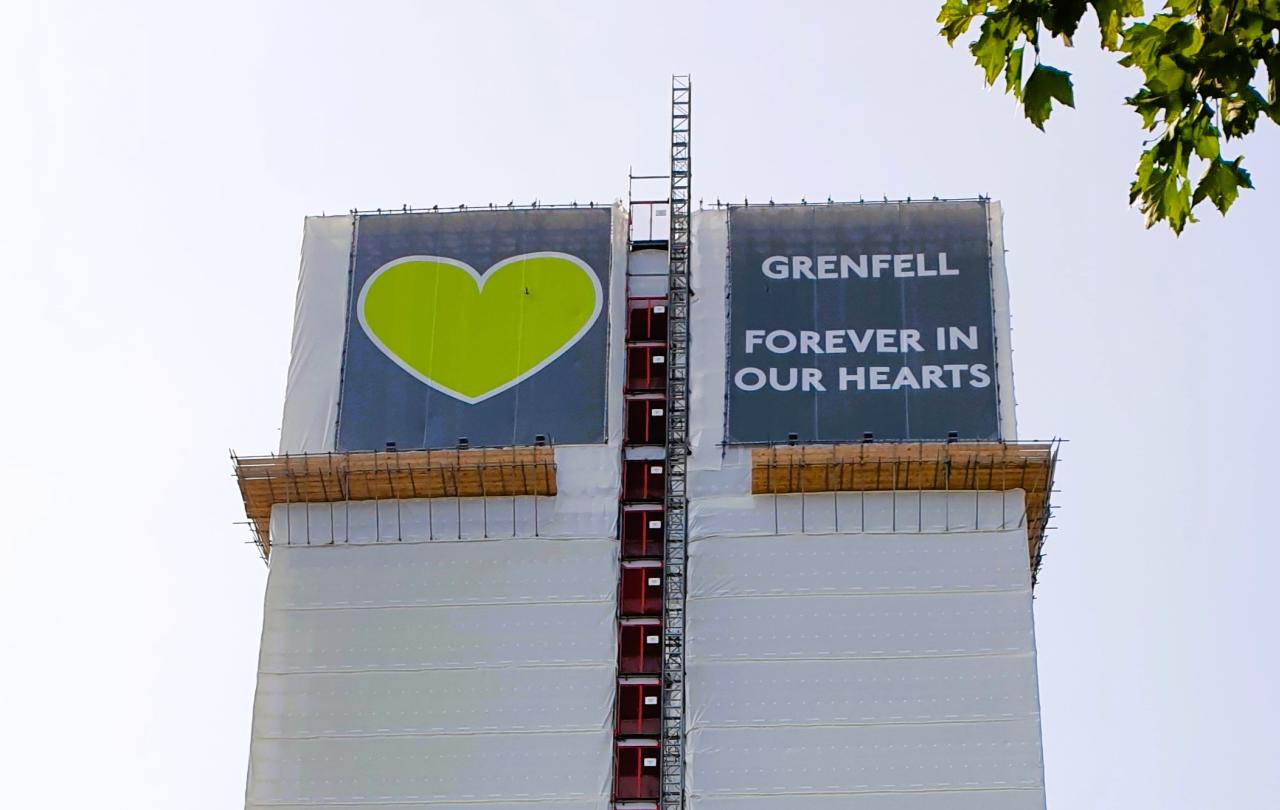
Graham Tomlin was Bishop of Kensington at the time of the Grenfell Tower fire. This is the first of a short series of articles reflecting on this milestone in our national life.
The Grenfell Inquiry report is brutal. None of the companies involved in the renovation of Grenfell Tower escape. Arconic, Kingspan, Rydon, Celotex, Exova and many others – all have a lot to answer for. Listening to the statement by Sir Martin Moore-Bick and reading the report, words such as ‘failure’, ‘dishonesty’, ‘misleading’, and ‘defective’ sounded like a tolling bell throughout his account.
This was a tragedy that was decades in the making. Reports came out, warnings were issued and routinely ignored. A government which led a campaign of de-regulation without looking at the consequences for safety, a local council that failed to plan ahead for such an event, a tenant management organisation that treated the tenants they were supposed to serve with disdain, all played their part. The construction industry fared even worse. A culture of unholy competition, ‘value engineering’ (another term for deception), cost-cutting, a scramble for market share all took precedence over the safety of the people who were going to live in the newly clad flats of Grenfell Tower.
In the past, initial reports such as those on Bloody Sunday in Northern Ireland and on the Hillsborough disaster, were weak affairs, failing to listen to the voices of victims, too careful to preserve the status quo, only leading to further anger, and further reports which finally began to address the key issues. This report has not pulled its punches – perhaps because they kept the human side of the tragedy in mind throughout.
In the early stages, in an inspired move, the Inquiry decided to offer an opportunity for bereaved family members to simply describe the people who died in the fire. It was intensely moving as the richness and colour of each person was described, celebrated and mourned. As a result, this Inquiry has never quite lost the human nature of this tragedy and I suspect that is why its results have been so hard-hitting.
No blame for the victims - instead he demands a radical national repentance, a re-examination of deeper social and spiritual trends, and for a radical turnaround of attitude.
Jesus and another tower
Remembering the human scale of the disaster is vital, yet in itself, it does not lead to change. At one point in his public teaching, Jesus was asked about another disaster involving a tower which led to the tragic death of a large number of people. At some point during Jesus’ time in Jerusalem, it seems a tower collapsed in a part of the city called Siloam, killing 18 people. This tragedy clearly had a significant impact across the nation, and people started asking what it meant, and what it said about the society in which they lived.
Jesus' words were harsh:
“Those who died when the tower in Siloam fell – do you think they were more guilty than all the others living in Jerusalem? I tell you, no! But unless you repent, you too will all perish.’”
No blame for the victims - instead he demands a radical national repentance, a re-examination of deeper social and spiritual trends, and a profound change of mindset. If they don’t, such disasters will continue to happen. When disaster strikes, it doesn’t say anything much about those caught up in it, but it does give us an opportunity to take a good look at ourselves.
Jesus said that the two most basic commandments, the things we should set out to do every day of our lives, were to love God and to love our neighbour - who is deserving of love because they are first made and loved by God. The Grenfell story is an object lesson in what happens when those commandments get ignored. This is what happens when these commandments are superseded by other imperatives, such as to increase market share, to beat the competition or to safeguard the reputation of our own organisation.
Grenfell was the result of a culture that has become so individualistic that we have lost sight of the fact that we are our brothers’ (and sisters’) keepers, that we have a responsibility for each other, and that we find purpose and meaning in loving our neighbours as we love ourselves, whoever they happen to be. I am sure that the employees of Arconic, Rydon, Kingspan and the Tenant Management Organisation of RBKC, would have done anything they could to ensure that they and their families enjoyed a safe and secure home. They simply failed to do that for those they were meant to serve through their work. They took care of themselves and their own. They lost sight of the people their work affected. They did not take care of their neighbour.
It is the individuals and institutions that have the resilience and flexibility to face up to failure, learn the lessons and to be open to change which ultimately excel.
What happens now?
Matthew Syed’s 2015 book Black Box Thinking looked at responses to catastrophic failure. He contrasted the approach of the medical profession with the aviation industry. Too often, he argued, when an error is made in the world of healthcare, the instinct is to cover up failure for fear of litigation or in order to protect reputations. As a result, he suggested, the same mistakes are often repeated, which means that thousands of people continue to die in hospitals every year due to preventable error. When a plane crashes, however, the ‘black box’ is recovered, data painstakingly analysed, and no stone is left unturned in order to determine the exact causes of the disaster to make sure that it never happens again. As a result, plane travel has become one of the safest means of transport we have.
The companies and organisations that were meant to protect the residents of Grenfell failed in that duty. Yet the moral of Syed’s story is that failure is not something to be feared — but an opportunity to change. It is the individuals and institutions that have the resilience and flexibility to face up to failure, learn the lessons and to be open to change which ultimately excel. It is what the Christian church calls confession and repentance – the willingness to admit when we have got something wrong, bear the consequences, ask for forgiveness, resolve to learn from the error of our ways and to become a better person through it. Repentance is not wallowing in self-pity or hiding in a corner from the wagging finger of guilt; it is an invitation to honesty, to growth and to transformation.
Those responsible will need to face justice. Yet if we allocate blame, punish the guilty, and then carry on as before, then there is no guarantee that something like this will not happen again. We might issue new types of building regulations, or safety measures in construction, but even that would not be enough. The kind of repentance that Jesus, and indeed the Grenfell Tower fire calls for is deeper - a radical look at the way we live together in our society.
This involves all of us. As Andrew O’Hagan put it in a long article soon after the fire in the London Review of Books:
“In all the loosening of cares and controls and emergency services, it’s not just the current government but a succession of them that lie behind those deaths, and who, if not all of us, voted such vulnerability into existence? No one did well. If civic life is dead, with a 24-storey tombstone beside the Westway, it died in the times in which we too lived, and by the values we lived by. The point of a society, if we have one, is that when bad things happen, it’s everybody’s concern.”
Grenfell is such an opportunity that we dare not let pass. If we carry on as normal, with our atomised individualism, our addiction to comfort, our spiritual poverty, our disregard for our neighbours, we would miss a huge opportunity to address some of the deeper issues in our life together, not to speak of refusing to heed the call of Jesus for true repentance.
In his statement in the House of Commons, Keir Starmer pledged a “profound shift in culture and behaviour.” I hope - and pray - this is what happens. Yet it will take more than changes to building regulation and for safety. It needs spiritual and not just political change, as I’ve argued here before. It would mean each of us looking at ourselves, and the cultures of the organisations of which we are a part (yes - including the church), and responding to the call to love God – to re-orient our lives around something, someone bigger and better than us – and to love our neighbours as much as we love ourselves. What if Grenfell sparked a fundamental change back to that more connected vision of who we are and what we are here for? Grenfell - and this report - is a shock to our system. Let us not waste it.
Listen to Graham discuss Grenfell on BBC Radio 4's PM programme.





